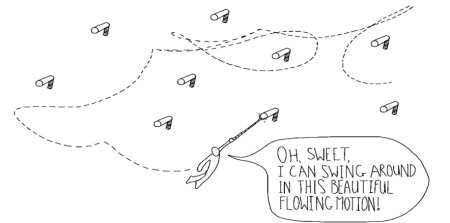This is my ninth monthly Patch Wednesday post where I discuss a question about video games that I think is unanswered, unexplored, or not posed yet. I will propose my own tentative ideas and invite comments.
The series is called Patch Wednesday to mark the sometimes ragtag and improvised character of video game studies.
I have come to think that there are four main theories of “fun”, or at least experience in video games. They are: Rules, Fiction, Social and Feel. When I teach game studies classes, I usually invite students to mention their favorite game and then discuss which of the categories it falls under. The categories are not exclusive, but they have their own favorite game examples.
Here they are:
1) Rules
This is still the primordial theory of games. According to this theory, (video) games are by definition (or essentially) rule-based structures, and the player’s experience hinges on rules that create interesting mental challenges for the player. This theory tends to claim that it has identified something unique about games.
It can of course then be extended from the description to the prescriptive, and claim that because games are defined by the presence of rules, all games should be centered on rules, with all other possible design elements (say, Fiction) being negative agents that dilute the purity of a game.
This theory has typically been promoted by game designers and people wishing to identify games as a unique art form. It is also very hard to imagine teaching video game design without it.
Favorite example: Go, StarCraft, Tetris.
2) Fiction
Another classic, this theory has some backing from especially the humanities, and argues that video games first and foremost are about experiencing, and possibly feeling immersed in, stories and fictions. This theory is particularly useful when we think about games in a cross-media perspective.
This theory has typically been promoted by literary and film scholars.
Favorite game examples: Final Fantasy, Uncharted, BioShock.
3) Social
This is a slightly different theory in that it doesn’t invoke the game’s content, but the social sphere around it. The paradigmatic game genre for this theory is currently MMOs. And this is sensible as an explanation of why many players keep returning to this type of game.
The social theory also has a stronger version in which the social sphere isn’t simply something around the game, but it defines or is the game, both for multi- and single player games. (Mikael Jakobsson and Anne Mette Thorhauge are probably the main proponents of this strong version.)
Favorite game examples: World of Warcraft, Dungeons & Dragons, Wii Sports.
4) Feel
Feel is the newer theory, and it is only really articulated Steve Swink’s book on Game Feel. Here, video games are seen as centered on the immediate sub-second experience on controlling something and receiving audio and visual feedback. This is the theory for discussing game controls, graphics and sound. (Yes, you could argue for graphics as a separate theory, but let’s just put it here).
It is also a good theory for teaching how game design often starts with narrowing down a central core mechanic which feels good as in the picture, and how designers must then add context around the core mechanic for it to remain interesting.
I suspect feel hasn’t been popular in media or literature departments because it talks about an experience which is very hard to verbalize, and hard to connect to existing theories. (Though Donald Norman’s Emotional Design has some family semblance).
Favorite game examples: Super Mario Bros, Super Mario Bros, Super Mario Bros.
The meaning of “is”
The question of course is what we mean when we say that a video game is anything in particular. As always, there is a fine line between:
- Proposing a particular description (“feel is one way to look at it”).
- Insisting on a particular description (“to ignore the social is to ignore the lived experience of players”).
- Insisting in having identified an essential component of video games (“without rules, there is no game”). (Though the rigid designator comes up here: it just is easier to claim a central position for rules than for, say, 3d graphics).
- Insisting that all video games should be made with a particular theory in mind.
There are other theories, of course, but I think these are the four dominant ones at the moment, November 2014.
PS. This 4-part list does not replace the (cough) ludology-narratology debate or the rules/fiction distinction in Half-Real. The rules/fiction distinction is about how the players conceptualize the game that they encounter. Feel and Social are theories about other aspects of game-playing.


Interesting!
Rules, Favourite example: Streetfighter
Fiction, Favourite example: Quest for Glory
Social, Favourite example: Chess
Feel, Favourite example: Streetfighter, Quest for Glory, and Chess
Do you think that “feel” is something in all games whether you like the feelings or not though. I agree that Super Mario is a good feeling game but all games make one feel something?
@Dan “Feel” is not about feelings in general, but about the tactile feeling of engaging with the interface (controls, visuals, sound), so I would not put chess there.
The counter-example would be the “feel” of owning a high-end chess board, where the tactile experience becomes important after all.
Hello Mr. Juul. One could also combine all these four: “Fictional Rules regarding the Feel of The Social” under something equally vague like ‘Play’. Also, your example of ‘Go’ feels problematic, since the ‘Rules’ of Go ‘is’ innately bound up with the Social Fictions surrounding its symbolic (even spiritual) meanings – its *strategic* expressions of a perceived mindset of a culture / people / nation. Finally, never forget that Ludology could also be just another (awkwardly self-bootstrapping) ‘Game’, comprised of whatever rules its players currently choose to definite itself / themselves ;-) Sincerely, R.H.D